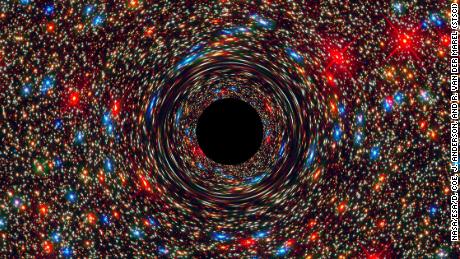Don Lincoln is a physics researcher. He is the author of "The Large Hadron Collider: The Extraordinary Story of the Higgs Boson and Other Stuff That Will Blow Your Mind" and produces a series of science education videos. Follow him on Facebook. The opinions expressed in this commentary are his.
(CNN)Modern scientists face several pressing mysteries in their quest to understand the laws of the universe. A recent discovery could represent a very substantial step forward in solving a couple of them.
Researchers operating at Fermi National Accelerator Laboratory (Fermilab), recently announced evidence for the discovery of a new kind of particle called a sterile neutrino. If confirmed, the existence of sterile neutrinos would be a remarkable breakthrough for the scientific community.
But the excitement wouldn't stop there. If, in fact, this type of particle exists, it is a candidate for dark matter, a hypothesized form of matter that hasn't been directly observed, but would explain many astronomical puzzles (like the fact that galaxies rotate faster than can be explained by the matter we see they contain and the known laws of gravity).
Dark matter is five times more prevalent than ordinary matter and, if the recent measurement holds up, this would be a huge deal.
Even more tantalizing, if sterile neutrinos were observed, they were not observed by a dark-matter-seeking experiment. Instead, they are a proposed solution to a different problem involving a subatomic particle that seems to be constantly changing its very identity. This subatomic particle is called the neutrino.
Fermilab is America's leading particle physics laboratory and it has embarked on an ambitious plan to lead neutrino research for the next few decades. When researchers made their recent observation, they weren't looking for dark matter. Instead they were studying neutrinos.
While sterile neutrinos are still hypothetical, ordinary neutrinos are solidly accepted physics. There exist three known types of ordinary neutrinos, like the three flavors of Neapolitan ice cream. Because ordinary neutrinos interact only via the weakest of the forces that act on particles smaller than atoms, they are the ghosts of the subatomic world and can penetrate the entire Earth essentially unscathed. It is possible to stop neutrinos, but it would take more than a lightyear of solid lead to absorb half of them.
Neutrinos are made in nuclear processes (think nuclear reactors and atomic explosions) and in particle accelerators. In 1998, it was observed that the three types of neutrinos could "oscillate," which is they would change their identity, with type 1 turning into one of the other two types and then back to 1 in an endless cycle.
With the observation of neutrino oscillation, the world's physics community turned their attention to the phenomenon. They were interested in learning such things as the speed at which the neutrinos oscillated and the rate at which a particular neutrino type turned into each of the other two. Another important parameter was the difference in the masses of the neutrino types because neutrino oscillation depends not on the specific mass of neutrinos, but rather how much they differ from one another.
Studying neutrinos became an intellectual industry. There were dozens of independent experiments telling a consistent story, each reporting similar values for the parameters being studied. Well, except for one.
The Liquid Scintillator Neutrino Detector, or LSND collaboration used a beam of neutrinos generated by the accelerator complex at the Los Alamos National Laboratory for their research. But what they found was that their measurement was inconsistent with the reports of other scientists. The only way they could make sense of their measurements was if there existed not three types of neutrinos participating in neutrino oscillations, but rather four or more.
Further, these extra kinds of neutrinos were not the ordinary kind. Remember that ordinary neutrinos are affected by the weakest of the subatomic forces. These new types of neutrinos did seem to oscillate, but didn't feel this weak force. Thus, they were called sterile neutrinos, to indicate their indifference to the forces the other neutrinos experienced.
These sterile neutrinos could have significant mass and are therefore a possible candidate for dark matter. After all, dark matter is an undiscovered particle that experiences gravity and none of the other known forces. The non-interacting sterile neutrino perfectly fits the bill.
Normally when only one experimental result differs from all of the others, it is considered to be a mistake of some sort. While rare, that sort of thing happens in frontier research -- blunders can occur or sometimes it's just a mathematical fluke.
In general, the neutrino science community treated the LSND experiment as one of these -- a curiosity that was likely wrong. However, scientists are a cautious bunch and it was possible that LSND found something that other researchers missed, so a follow-on experiment was proposed and conducted, called the MiniBooNE experiment, this time located at Fermilab.
Unlike all the other experiments, which produced results that contradicted the LSND anomaly, MiniBooNE's measurement agreed with LSND. If the MiniBooNE measurement is correct, then it appears that LSND might have been right all along. Further, if one combines the MiniBooNE and LSND data, the aggregate measurement satisfies the criterion for claiming a discovery.
Ordinarily, an announcement like this would blast its way across the scientific world, with a trip to Stockholm for the brilliant discoverer, but caution is still warranted. While LSND and MiniBooNE announced compatible results, it turns out that some of the same researchers who were part of the LSND effort were also part of the team that published the MiniBooNE experiment results.
This means that the new measurement is not completely independent of the first one. And, of course, there are all those other measurements that disagree.
So, did LSND and MiniBooNE find something that the rest of the scientific community missed? Maybe. It's entirely possible that these researchers were the clever ones, with an insight that the rest of the neutrino research world overlooked or a capability that the others lacked.
Or possibly, the two experiments made a similar mistake, resulting in a similar misleading result. Given the stakes for how this announcement might alter our understanding of the fundamental rules of nature, it is important to be incredibly cautious. A third confirming measurement is necessary.
Luckily, Fermilab has launched a multidecade effort to lead the world in neutrino research. Several new experiments, with the names MicroBooNE, ICARUS, and SBN, are under construction or have recently begun operation. These newer experiments have far superior capabilities compared to the earlier LSND and MiniBooNE experiments. Within a few years, it is likely that one or all of these newcomers will weigh in and tell us if sterile neutrinos are a new denizen of the subatomic pantheon, or just a scientific will-o'-the-wisp.








